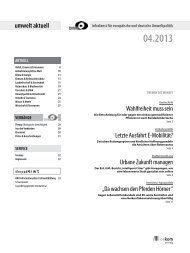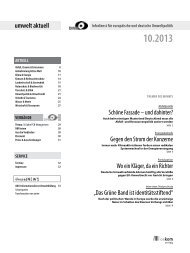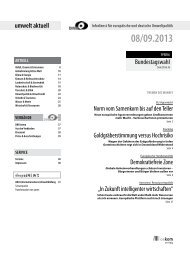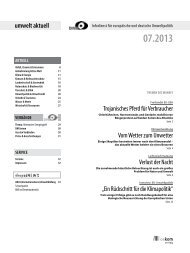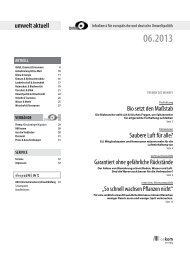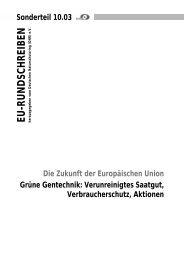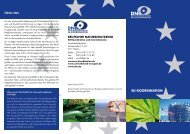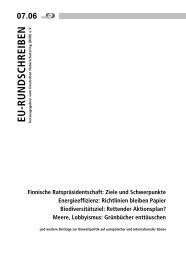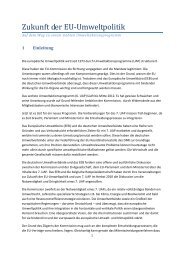Nachhaltiges Europa Abschlusspublikation - Global Marshall Plan
Nachhaltiges Europa Abschlusspublikation - Global Marshall Plan
Nachhaltiges Europa Abschlusspublikation - Global Marshall Plan
Sie wollen auch ein ePaper? Erhöhen Sie die Reichweite Ihrer Titel.
YUMPU macht aus Druck-PDFs automatisch weboptimierte ePaper, die Google liebt.
<strong>Nachhaltiges</strong> <strong>Europa</strong><br />
Strengthening Sustainable Development in the EU<br />
Günther Bachmann 2 , Rat für Nachhaltige Entwicklung. Leiter der Geschäftsstelle<br />
Where we are: Europe’s Strategy for Sustainability<br />
as Unfinished Business<br />
2 Zusammen mit: Derek Osborn, Member of the UK Sustainable Development Commission (UK SDC)<br />
18<br />
The EU Sustainable Development Strategy (EU-<br />
SDS) is a moving asset: The Lisbon and Gothenburg<br />
European Councils conclusions and the<br />
Johannesburg commitments are forming the politically<br />
binding essence of the EU-SDS, with the<br />
Gothenburg conclusions defining its environmental<br />
dimension while the 6th Environmental Action Pro-<br />
gramme (6EAP) and the Cardiff integration process<br />
supplement the environmental dimension of<br />
sustainable development in Europe. Also of rele-<br />
vance for European sustainable development policies<br />
were the Commission Spring Reports and the<br />
Commission's Communication "A sustainable<br />
Europe for a better world", which the Gothenburg<br />
Council draws upon. These documents are intertwined<br />
and refer to each other, making it difficult<br />
to pinpoint content and scope of a European<br />
Sustainable Development Strategy.<br />
The following recommendations focus mainly on<br />
strengthening the environmental dimension of<br />
sustainable development in the EU Sustainable<br />
Development Strategy and in the regular annual<br />
cycles of review, while not overlooking the eco-<br />
nomic and social dimensions.<br />
Positive Features and Shortcomings<br />
The EU-SDS has a number of positive features.<br />
The EU-SDS provides a general and comprehen-<br />
sive framework for sustainable development in the<br />
EU. It is a widely appreciated effort to set guidelines<br />
for political leadership at the highest level<br />
and it shows consistency to the extent that it repeats<br />
and underlines features of primary importance,<br />
e.g. decoupling of economic development<br />
and resource consumption and reform of environmentally<br />
adverse subsidies. The EU-SDS calls for<br />
the implementation of specific measures within<br />
specified timeframes. It recognises the need to<br />
take action deemed necessary in the pursuit of<br />
sustainable development, such as to reach an<br />
agreement on the energy tax directive or the di-<br />
rective on environmental liability.<br />
Some of these concrete measures begin to flesh<br />
out the more abstract overall framework of the<br />
strategy. In sum, the present EU-SDS provides a<br />
reasonably balanced mix of long-term targets and<br />
specific short-term measures, and is clearly point-<br />
ing in the right direction for sustainability. Also reflected<br />
in the quantity and quality of proposed<br />
measures, the Brussels European Council of March<br />
2003 contains positive features, e.g. its call to re-<br />
vive the Cardiff Process and its proposals to increase<br />
maritime safety. The review and coordination<br />
process, as envisaged by EU-SDS, has<br />
positive elements. The EC, comprised by the Head<br />
of States and Governments, reviews the EU-SDS,<br />
including its environmental dimension. The annual<br />
rhythm ought furthermore to offer a regular opportunity<br />
to assess progress. However, the EU-<br />
SDS and its current status has several shortcomings:<br />
Outdated concepts and insufficient attention to<br />
the environmental dimension.<br />
Although the Barcelona European Council calls to<br />
give equal attention to all three dimensions during<br />
policy-making and decision-taking processes, environmental<br />
considerations have apparently not<br />
been as high on the political agenda as their economic<br />
and social counterparts. The EU-SDS still<br />
has a strong focus on economic policies, as reflected<br />
by the economic bias of the Spring Re-<br />
ports, in particular the 2002 Report. In addition to<br />
this shortcoming, the EU-SDS economic dimension<br />
is driven by traditional policy issues. The way in<br />
which social welfare and economic growth are<br />
looked upon is short term orientated and follows<br />
the concept of adding environmental policies as a<br />
follow-up to economic progress. This is an outdated<br />
concept. Sustainability needs economic policies<br />
to reflect criteria such as intergenerational<br />
justice and the long-term assessment of capital<br />
and natural stocks. Primary features of the EU-<br />
SDS such as decoupling fall short in many cases<br />
and lack timetables and roadmaps. Also, the re-<br />
vival of the Cardiff Process still has not succeeded.



